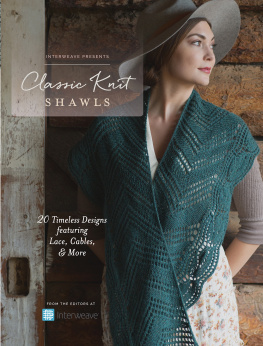Contents
Guide
23 Sophisticated Designs
Yumiko Alexander

CONTENTS
Introduction
When my first book with Interweave, Rustic Modern Crochet, was published, I was delighted to read book reviews stating that the designs were simple, created with eye-catching construction, and both a pleasure to work with and wear. I love working with simpler shapes, so I can enjoy knitting and crocheting while creating unique finished garments. This is the reason we make handmade items!
I was born in Japan and lived there until my late twenties, when I got married and moved to America. I started knitting at the age of eleven, learning from a knitting book, because I loved working with my hands. I started designing in high school, and I had the chance to meet a knitting designer who taught me how to design. I started to sell my original finished knitted garments at exhibitions and at a store in Japan.
I have really enjoyed my time in the United States. Now that I have started sharing my knitting and crochet designs, this country feels like a second home to me. Although my English is not perfect, I have always felt like I can communicate and express myself through my design work. I have met many wonderful friends through knitting and crochet.
When Interweave told me they were interested in publishing a knitting book to follow Rustic Modern Crochet, I was ecstatic. I wanted to focus on accessories that are unique and different. I have tried to produce knitted designs that resemble crochet (Allium, Hydrangea), take the shape of huge squares using the entrelac technique (English Garden), bloom into dimensional motifs (Pansies), and evolve as layered knitted fabric (Allium). As with some of my previous designs, I have tried to keep the silhouettes simple without shaping (Acorns and Ivy, Allium, Bricks, English Garden, Hyacinth, Japanese Lanterns, Lace Lichen, Lattice, Lily of the Valley, Midnight Tendril, Winter Rose). At times the pieces are nonsymmetrical (Babys Breath, Clematis, Hyacinth) or asymmetrical (Field of Wheat, Waves of Grain).
My design ideas come from what I want to have in my closet, and each design needs to be something I cant find in the usual clothing stores. I want to create designs I can be proud to wear and use, both functional and fashionable. I hope the same holds true for you as you create these garments!
Yumiko Alexander
Bricks
I was designing a sweater with self-striping yarn several years ago and became interested in how the color flows differently depending on the stitch pattern. This cowl is worked in two textured stitch patterns, and the textures show much more clearly than when using a solid color yarn. The pop-up stitch pattern is especially interesting to work with self-striping yarn because one color stays on top to make each pop-up. Pop-ups are created by working short sections with extra rows.
Finished Size
About 1412" (37 cm) wide and 6112" (156 cm) circumference.
Yarn
DK weight (#3 Light).
Shown here: Schoppel Wolle Zauberball Starke 6 (75% superwash wool, 25% nylon; 437 yd [400 m]/150 g): #1701, 2 balls.
Needles
Size U.S. 6 (4 mm).
Adjust needle size if necessary to obtain the correct gauge.
Notions
Smooth waste yarn for provisional cast-on; tapestry needle.
Gauge
20 sts and 36 rows of main patt = 4" (10 cm) wide and 512" (14 cm) long after blocking.
20 sts and 20 rows = 4" (10 cm) in pop-up patt after blocking.
Stitch Guide
Sl 2tog pwise tbl
With yarn in front, slip 2 sts together as if to p2tog tbl.
Pop-up Pattern (multiple of 14 sts + 2)
Row 1: (RS) K1, *[k7, turn, p7, turn] 4 times, k14; rep from * to last st, k1.
All even-numbered rows: K1, purl to last st, k1.
Row 3: Knit.
Row 5: K8, *[k7, turn, p7, turn] 4 times, k14; rep from * ending last rep with k8 instead of k14.
Row 7: Knit.
Row 8: Rep Row 2.
Rep Rows 18 for patt.
Main Pattern (multiple of 4 sts + 2)
Rows 14: Knit.
Row 5: *K1, work (k1, yo, k1) all in the same st, turn, p3, turn, k3; rep from * to last 2 sts, k2.
Row 6: K1, *p1, sl 2tog pwise tbl (see ), p1, pass 2 slipped sts over st just worked (p2sso); rep from * to last st, k1.
Row 7: K1, *k1, work (k1, yo, k1) all in the same st, turn, p3, turn, k3; rep from * to last st, k1.
Row 8: K1, *sl 2tog pwise tbl, p1, p2sso, p1; rep from * to last st, k1.
Rows 916: Knit.
Row 17: *Insert needle into next st and wrap yarn twice around needle, then knit the st withdrawing all the wraps along with the needle; rep from * to end.
Row 18: *Knit working only into the first loop and dropping the 2nd loop to create an elongated stitch; rep from * to end.
Rows 1922: Knit.
Row 23: *Insert needle into next st and wrap yarn 3 times around needle, then knit the st withdrawing all the wraps along with the needle; rep from * to end.
Row 24: *Knit working only into the first loop and dropping the 2nd and 3rd loops to create an elongated stitch; rep from * to end.
Rows 2532: Knit.
Rows 3336: K1, *yo, ssk; rep from * to last st, k1.
Rep Rows 136 for patt.
Instructions
With smooth waste yarn and using a provisional method (see ), CO 86 sts.
Set-up row: (WS) Purl.
Rows 180: Work Rows 18 of Pop-up patt (see ) a total of 10 times.
Rows 81332: Work Rows 136 of Main patt (see ) a total of 8 times.
Rows 333345: Work Rows 113 of Main patt once more.














